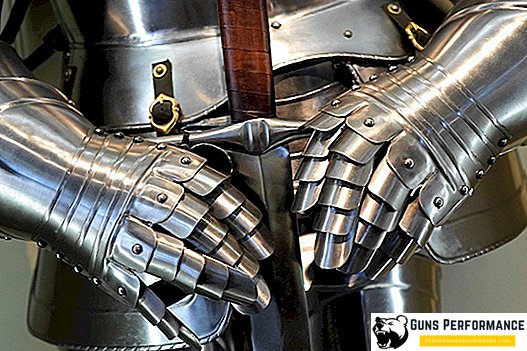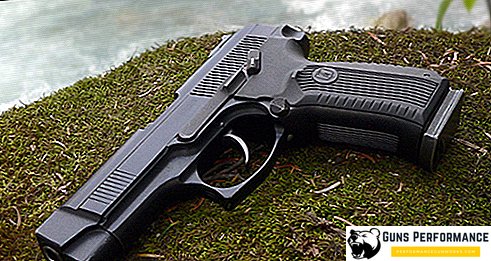Continuation of the review of the most ancient cold piercing weapons in the history of mankind. Very soon, people realized that the spear is fraught with considerable development potential. The spear was noted on almost every page of the chronicles. To date, there are many varieties of copies. We will try to consider the most famous of them.
Peak
This version of the weapon is perhaps the closest to the "original" purpose of the spear. The tip of the pike was impaled on a long shaft and could be both flat and faceted. The last modification was called "armor-piercing" and was intended to pierce the armor. What, in fact, successfully and did, because the faceted tip was much tougher than a flat and successfully withstand a collision with iron of armor or chain mail. Pika equally well “worked” both in Tatar kuyak and in solid breastplates of European warriors.

The hitting of the honed metal in the chest caused, at a minimum, pneumothorax, which the healers of that time could not treat. Particularly advanced warriors made the blade (this name seems to be true for a piece of metal, whose side edges were sharply honed) jagged. When trying to remove the spear from the body of the enemy, the teeth inflicted additional damage.

In short, in the hands of an experienced fighter, these weapons were very dangerous. But human thought, as was rightly said before us, does not stand still. Especially in the field of creating means of killing one’s own kind. The rumor of men has preserved legends about those who, having received a pike in the chest or stomach, pulled themselves up by the pole and “explained” to the enemy how much he was wrong. Perhaps those times people were stronger and painful shock for them was just an annoying nuisance. However, the spearhead soon received a limiter and the weapon began to be called
Rohatina
Its tip lengthened and looked like a sword blade. In some encyclopedias, the classical variant is an analogue of the Roman gladius, who lost a handle, but received a wide crosshairs. It is not known for certain how widely such a device was used in military operations, but such weapons were very popular among large-game hunters. Scenes of bear hunting with a spear can be found in G. Senkevich's Crusaders and in the annals. Hunting with a spear was considered "lordly" fun and, indeed, it was not disdained by noble people, including rulers.

The most famous cattle belonged to the Prince of Tver Boris Alexandrovich. The date of its manufacture is considered to be in 1450. The weapon is richly decorated with gold inlay, so it is difficult to assume that it was intensely exploited for its intended purpose.
Lovers of exotic hunting on the spear used to this day - but only under the supervision of experienced rangers. The duties of the latter include not only the hunter's safety net, but also the protection of animals whose population is under threat. So you can hardly bring two or three bear carcasses from hunting.
Analogs of the hunting rat used in the war. They were quite successfully used by the infantry against the fighting cavalry. Of course, once in service with the regular army, the cattle underwent some changes. First, the weight of the weapon has decreased. If the cattle as a whole (tip plus pole) could weigh up to five kilos, then the army version was much easier. The cross has become two additional points, due to which the small tree (the so-called battle rattle) is sometimes referred to as variations of the forks.
The tactics of using this weapon almost did not change compared with hunting techniques. The shaft rested on the ground, and the tip was exposed with a point to the enemy. But if, as a rule, a few rogatinians were operating on the hunt, then in war they were put together in a light fortification, which well kept up the onslaught of cavalry. But apparently, the spear was so successful invention that its evolution continued. And there was ...
Sovnya
Imagine the curve of the blade on a very long handle - and you get an idea about this weapon. It was possible to inflict not only stabbing, but also chopping blows. The latter, presumably, were rarely used, and this was justified by two reasons. Firstly, in close formation such a thing will not swing without the risk of offending your own, and secondly, the owl possessed considerable inertia, which made it difficult to handle it.
However, one skilled warrior with an owl, being surrounded by enemy swordsmen or even spearmen, could relatively easily keep around him the “free from passers-by” zone. Only an archer or crossbowman could strike him.

Similarity sovni can be considered as a glafu. This weapon is structurally very similar to an owl, but much more well known. Glaive was especially popular during the time of the Venetian Republic. The guards of the local doges were armed with these weapons, but reliable information about their combat use has not survived to our days - unlike the samples of the weapon itself, which was decorated with gold leaf and etched patterns. Therefore, many lovers of spear weapons believe that the glaive were only ceremonial weapons, designed to emphasize the position of the Doge in society. In general, something like pure silver hatchets that armed the guards of John IV, known in history as the Terrible. But the development of the spear did not stop there either. Its further evolution led to the emergence of such a subject as
Halberd, or the Vatican Long Knife
Precisely so, the "long knife of the Vatican", according to the testimony of the participants of the crusades (and they remain in the library of the papal state to this day), the Saracens called the hybrid of a spear and battle ax.
And here we step on thin ice of contradiction. Fans of cold weapons can not agree, take a halberd a spear or an ax on a long pole. However, this is the fate, probably, of any successfully designed weapon. Take, for example, a Kalashnikov assault rifle: consider it a submachine gun or assault rifle? Disputes about this no, no, yes, and arise among gunsmiths. So with a halberd. That's only if the cattle is currently used only by rare lovers to tickle their nerves while hunting, then the halberd is in service today.
Of course, the "long knives" in the hands of the Vatican troops - the Swiss Guards - now look like an anachronism, but tradition is a tradition. And it seems that if such a need happened, the halberdiers in the blue-golden uniform made no less trouble than their ancestors, who had once gone to liberate the Holy Sepulcher from the hands of non-Christ.
Structurally, the halberd is an ax with a tip (less often two or more), allowing to use it as a spear. A characteristic feature of the halberd is the presence of a hook, which was convenient to pull the rider off his horse. Judging from the images of some types of halberds (for example, Italian), it was the hook and the sharp tip that were the main combat units of the halberd.
The chopping part was often purely symbolic, which makes it possible to attribute the halberd to spears rather than to battle axes with a high degree of confidence. However, the same crusade participants demolished many Saracen heads with halberds with crescent-shaped blades. It was almost impossible to dodge a blow with such an ax precisely because of its shape. Wherever the enemy moved, right or left, honed steel was waiting for him everywhere.
Should the halberd be considered the pinnacle of the evolution of the piercing weapon or is it still attributed to the slashing weapon? Probably the answer to this question everyone must choose according to his taste.












